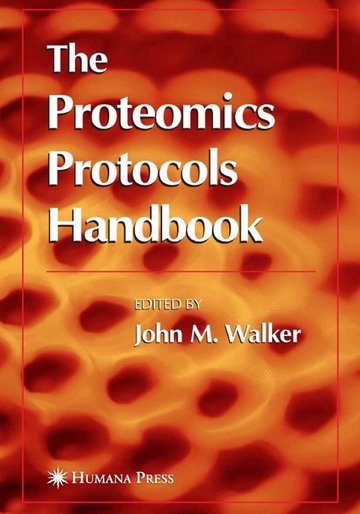| Preface | 5 |
| Contents | 6 |
| Contributors | 11 |
| Extraction and Solubilization of Proteins for Proteomic Studies | 17 |
| Preparation of Bacterial Samples for 2-D PAGE | 35 |
| Preparation of Yeast Samples for 2-D PAGE | 43 |
| Preparation of Mammalian Tissue Samples for Two- Dimensional Electrophoresis | 47 |
| Differential Detergent Fractionation of Eukaryotic Cells | 52 |
| Serum or Plasma Sample Preparation for Two- Dimensional Gel Electrophoresis | 64 |
| Preparation of Plant Protein Samples for 2-D PAGE | 70 |
| Laser-Assisted Microdissection in Proteomic Analyses | 73 |
| Purification of Cellular and Organelle Populations by Fluorescence- Activated Cell Sorting for Proteome Analysis | 81 |
| Purification of Nucleoli From Lymphoma Cells and Solubilization of Nucleolar Proteins for 2- DE Separation | 93 |
| Prefractionation of Complex Protein Mixture for 2-D PAGE Using Reversed- Phase Liquid Chromatography | 100 |
| Fractionation of Complex Proteomes by Microscale Solution Isoelectrofocusing Using ZOOM Ù IEF Fractionators to Improve Protein Profiling | 109 |
| Large-Format 2-D Polyacrylamide Gel Electrophoresis | 130 |
| Analysis of Membrane Proteins by Two-Dimensional Gels | 143 |
| 2-D PAGE of High-Molecular-Mass Proteins | 155 |
| Using Ultra-Zoom Gels for High-Resolution Two- Dimensional Polyacrylamide Gel Electrophoresis | 160 |
| NEpHGE and pI Strip Proteomic 2-D Gel Electrophoretic Mapping of Lipid- Rich Membranes | 175 |
| Silver Staining of 2-D Gels | 184 |
| Zn2+ Reverse Staining Technique | 192 |
| Multiplexed Proteomics Technology for the Fluorescence Detection of Phosphorylation and Protein Expression Levels Using Pro-Q® Diamond and SYPRO® Ruby Dyes | 208 |
| Sensitive Quantitative Fluorescence Detection of Proteins in Gels Using SYPRO® Ruby Protein Gel Stain | 216 |
| Ruby Protein Gel Stain | 216 |
| Rapid, Sensitive Detection of Proteins in Minigels With Fluorescent Dyes | 222 |
| Differential In-Gel Electrophoresis in a High-Throughput Environment | 230 |
| Statistical Analysis of 2-D Gel Patterns | 245 |
| 2-DE Databases on the World Wide Web | 265 |
| Computer Analysis of 2-D Images | 273 |
| Comparing 2-D Electrophoretic Gels Across Internet Databases | 284 |
| Sample Cleanup by Solid-Phase Extraction/Pipet-Tip Chromatography | 311 |
| Protein Identification by In-Gel Digestion and Mass Spectrometric Analysis | 314 |
| Peptide Sequences of 2-D Gel-Separated Protein Spots by Nanoelectrospray Tandem Mass Spectrometry | 318 |
| Identification of Proteins by MALDI-TOF MS | 322 |
| Sequencing of Tryptic Peptides Using Chemically Assisted Fragmentation and MALDI- PSD | 328 |
| The In Situ Characterization of Membrane-Immobilized 2-D PAGE-Separated Proteins Using Ink-Jet Technology | 344 |
| Protein Identification by Peptide Mass Fingerprinting | 358 |
| Analysis of the Proteomes in Human Tissues by In-Gel Isoelectric Focusing and Mass Spectrometry | 369 |
| Liquid Chromatography Coupled to MS for Proteome Analysis | 377 |
| Quantitative Analysis of Proteomes and Subproteomes by Isotope- Coded Affinity Tag and Solid- Phase Glycoprotein Capture | 386 |
| Amino Acid-Coded Mass Tagging for Quantitative Profiling of Differentially Expressed Proteins and Modifications in Cells | 394 |
| Mass-Coded Abundance Tagging for Protein Identification and Relative Abundance Determination in Proteomic Experiments | 407 |
| Virtual 2-D Gel Electrophoresis by MALDI Mass Spectrometry | 416 |
| Identification of Posttranslational Modification by Mass Spectrometry | 429 |
| Approaches to the O-Glycoproteome | 436 |
| Identification of Protein Phosphorylation Sites by Mass Spectrometry | 455 |
| Quantitative Analysis of Protein Phosphorylation Status and Protein Kinase Activity on Microarrays Using Pro- Q Ù Diamond Dye Technology | 463 |
| New Challenges and Strategies for Multiple Sequence Alignment in the Proteomics Era | 470 |
| The Clustal Series of Programs for Multiple Sequence Alignment | 488 |
| FASTA Servers for Sequence Similarity Search | 498 |
| Protein Sequence Analysis and Domain Identification | 521 |
| Mammalian Genes and Evolutionary Genomics | 536 |
| Computational Identification of Related Proteins | 547 |
| Protein Identification and Analysis Tools on the ExPASy Server | 563 |
| Protein Sequence Databases | 600 |
| Characterization of Proteins | 610 |
| Computational Prediction of ProteinÒProtein Interactions | 619 |
| The Yeast Two-Hybrid System for Detecting Interacting Proteins | 643 |
| Antibody-Affinity Purification to Detect Interacting Proteins | 673 |
| Biomolecular Interaction Analysis Coupled With Mass Spectrometry to Detect Interacting Proteins | 679 |
| Assessment of AntibodyÒAntigen Interaction Using SELDI Technology | 689 |
| Protein and Peptide Microarray-Based Assay Technology | 698 |
| Production of Protein Microarrays Using Robotic Pin Printing Technologies | 711 |
| PCR-Directed Protein In Situ Arrays | 722 |
| Site-Specific Immobilization of Proteins in a Microarray | 730 |
| A Guide to Protein Interaction Databases | 739 |
| Deriving Function From Structure | 786 |
| Comparative Protein Structure Modeling | 815 |
| Classification of Protein Sequences and Structures | 845 |
| How to Use Protein 1-D Structure Predicted by PROFphd | 859 |
| Classification of Protein Folds | 886 |
| Protein Threading | 903 |
| High-Throughput Crystallography for Structural Proteomics | 921 |
| Automated High-Throughput Protein Crystallization | 936 |
| NMR-Based Structure Determination of Proteins in Solution | 948 |
















